Taipei, the vibrant capital city of Taiwan, is a captivating blend of modernity and tradition, offering a kaleidoscope of experiences for visitors. From towering skyscrapers to bustling night markets and serene temples, Taipei is a destination that seamlessly weaves together the old and the new. Whether you’re a cultural enthusiast, a food lover, or an urban explorer, Taipei has something to offer. In this article, we will explore the best things to do in Taipei, uncovering the city’s hidden gems and iconic landmarks that make it a must-visit destination in East Asia.
1. Chiang Kai-shek Memorial Hall
Chiang Kai-shek Memorial Hall, located in the heart of Taipei, Taiwan, is a prominent national monument dedicated to the memory of Generalissimo Chiang Kai-shek, the leader of the Republic of China from 1928 until his death in 1975. The memorial hall is a symbol of Taiwan’s complex political history and is an important cultural landmark in the country.
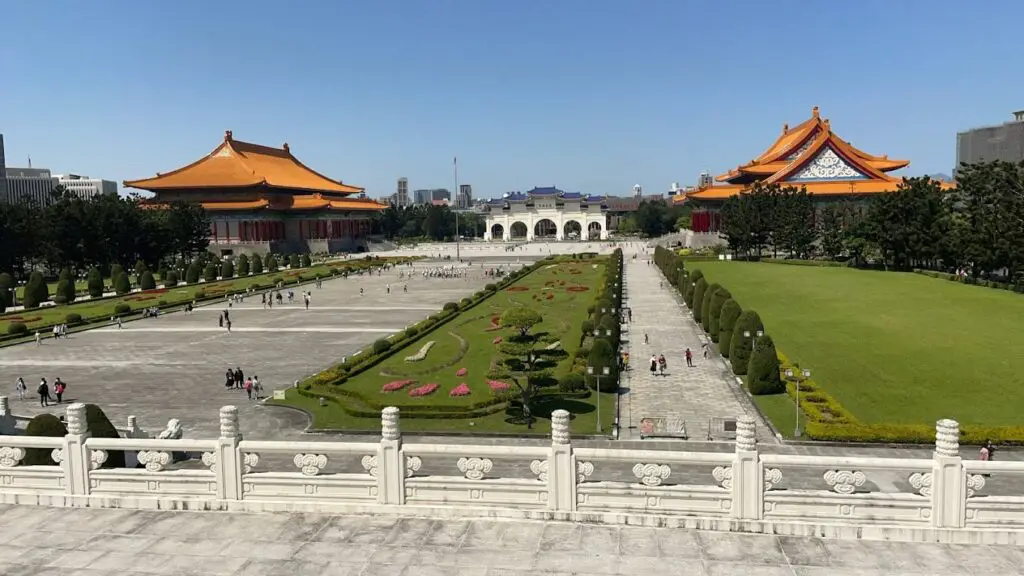
The structure, completed in 1980, is an imposing white building with a blue roof and stands at the east end of Liberty Square. Its design incorporates elements of traditional Chinese architecture, such as the octagonal shape representing the number eight, which is considered auspicious in Chinese culture. The hall is surrounded by large, manicured gardens and is flanked by the National Theater and National Concert Hall.
Visitors to Chiang Kai-shek Memorial Hall can witness the hourly changing of the guard ceremony, which is a meticulously choreographed display of military precision. The large bronze statue of Chiang Kai-shek inside the hall is a focal point, and the museum located in the basement provides insight into Taiwan’s political history during the 20th century.
The hall serves as a venue for various cultural events and is a popular spot for both locals and tourists. The significance of Chiang Kai-shek Memorial Hall extends beyond its architectural and historical value, as it reflects Taiwan’s journey towards democracy and its ongoing efforts to reconcile with its complex past.
Website: https://www.cksmh.gov.tw/
Location Map: https://maps.app.goo.gl/G3PCkyhguvLUnonJ9
2. Yangmingshan National Park
Yangmingshan National Park, situated just north of Taipei, Taiwan, is a picturesque and expansive natural reserve renowned for its diverse landscapes, hot springs, and volcanic topography. Established in 1985, the park covers an area of over 114 square kilometers, offering visitors a refreshing escape from the urban hustle and bustle.
One of the distinctive features of Yangmingshan is its volcanic terrain, evident in the numerous sulfur vents, hot springs, and fumaroles scattered throughout the park. The iconic Xiaoyoukeng, a post-volcanic geological area, showcases active sulfur vents and boiling springs, providing a unique opportunity for visitors to witness the earth’s geothermal activities up close.
Aside from its geological wonders, Yangmingshan boasts lush forests, flower-filled meadows, and scenic hiking trails, making it a popular destination for nature enthusiasts and hikers. One of the most beloved spots within the park is Qingtiangang, a highland meadow surrounded by dormant volcanic cones, offering breathtaking views of the surrounding mountains and valleys.
The park is also renowned for its vibrant seasonal flower displays, with cherry blossoms in spring and calla lilies in summer attracting crowds of locals and tourists alike. Yangmingshan National Park stands as a testament to Taiwan’s commitment to preserving its natural beauty and providing a sanctuary for those seeking a tranquil retreat in the midst of stunning landscapes.
Location Map: https://maps.app.goo.gl/ctZ88cLxFjzQQeBd8
3. National Palace Museum
The National Palace Museum, located in Taipei, Taiwan, is one of the most renowned museums in Asia and houses an extraordinary collection of Chinese art and artifacts. Established in 1925, the museum originally began in Beijing’s Forbidden City and later moved its extensive collection to Taiwan in 1949 during the Chinese Civil War to prevent the loss of these invaluable cultural treasures.
The museum is situated in a grand building resembling a traditional Chinese palace, with a stunning architecture that complements the richness of its contents. The collection spans over 8,000 years of Chinese history and includes a vast array of artifacts, including paintings, ceramics, jade, calligraphy, and other precious items that showcase the artistic and cultural heritage of China.
Visitors to the National Palace Museum can explore the exhibits across multiple galleries, each offering a deep dive into different periods and aspects of Chinese history. Notable pieces in the collection include the famous Jadeite Cabbage, the Qing Dynasty’s intricate jadeite carving of a cabbage with a locust, and the meat-shaped stone, a piece of jasper carved to resemble a slab of braised pork.
The museum’s commitment to preserving and showcasing China’s cultural legacy makes it a must-visit destination for those seeking a comprehensive understanding of Chinese art and history.
Website: https://www.npm.gov.tw/
Location Map: https://maps.app.goo.gl/BLePGcfGDF3VN9gh6
4. Liberty Square Arch
Liberty Square Arch, situated in the heart of Taipei, Taiwan, is a prominent landmark that holds historical and symbolic significance. Completed in 1966, the arch stands at the main entrance to Liberty Square, a vast public plaza surrounded by key government buildings. The arch is a classical Chinese architectural structure, featuring intricate carvings and adorned with decorative elements such as dragons and phoenixes, representing traditional Chinese symbolism.
The arch was originally built to commemorate the establishment of the Republic of China and is inscribed with the words “Liberty Square,” emphasizing the values of freedom and democracy. Liberty Square Arch serves as a gateway to several important institutions, including the National Chiang Kai-shek Memorial Hall, the National Theater, and the National Concert Hall. Its strategic location at the entrance of Liberty Square makes it a focal point for various events and gatherings.
The arch’s grandeur and historical significance make it not only a visually striking architectural feature but also a symbol of Taiwan’s commitment to democratic ideals and a reminder of its complex political history. Visitors to Taipei often find Liberty Square Arch to be a captivating site, offering a glimpse into the cultural and political heritage of Taiwan.
Location Map: https://maps.app.goo.gl/ruDsKMc7BMazJ7ES6
5. National Taiwan Museum
The National Taiwan Museum, located in Taipei, is the oldest museum in Taiwan and a key institution in preserving the island’s rich cultural and natural heritage. Established in 1908 during the Japanese colonial era, the museum’s original purpose was to showcase Taiwan’s resources and promote Japanese imperial policies.
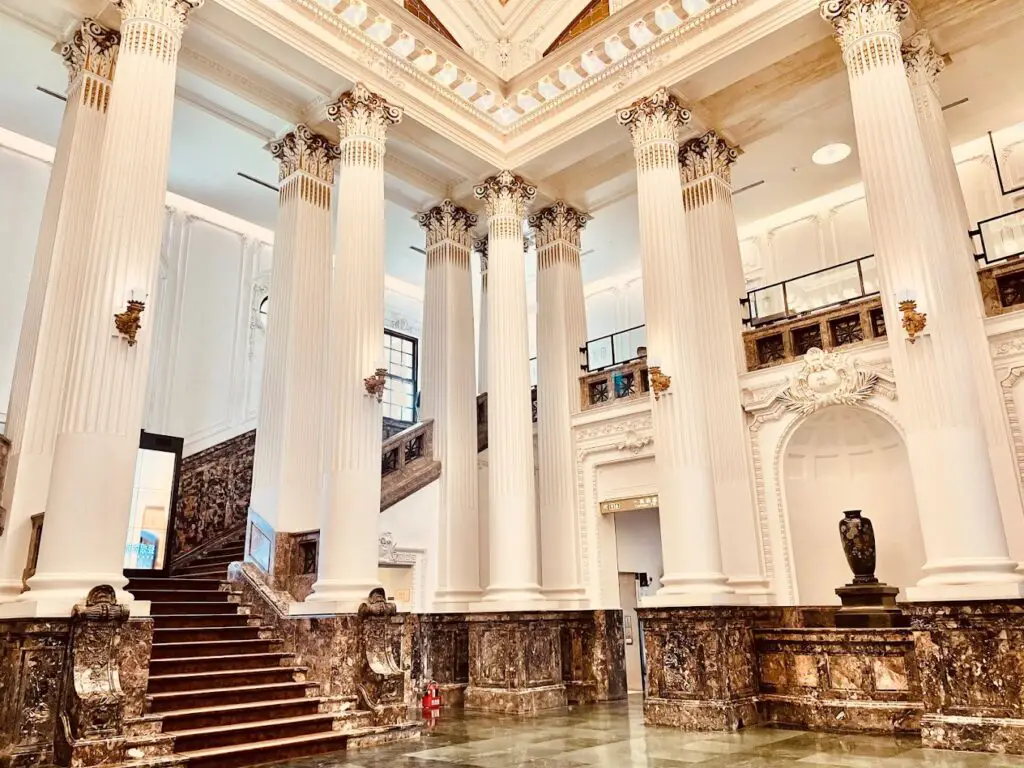
After World War II and the end of Japanese rule, the museum underwent a transformation, becoming the National Taiwan Museum and shifting its focus to encompass the diverse history, anthropology, and natural sciences of Taiwan. The museum is housed in a stately Baroque-style building, completed in 1915, which adds to its historical charm.
The National Taiwan Museum features a comprehensive collection that spans multiple disciplines, including anthropology, archaeology, ethnology, and natural history. Exhibits cover a wide range of topics, from the indigenous cultures of Taiwan’s various ethnic groups to the island’s geological and ecological evolution. Notable artifacts include ancient Taiwanese artifacts, traditional costumes, and specimens of the island’s unique flora and fauna.
The museum serves as an important educational and cultural institution, offering visitors a deeper understanding of Taiwan’s complex history and diverse heritage. With its commitment to showcasing Taiwan’s past and present, the National Taiwan Museum stands as a valuable resource for both locals and international visitors seeking to explore the island’s multifaceted identity.
Location Map: https://maps.app.goo.gl/1WLZafdpX1ncvNUN7
6. Daan Forest Park
Daan Forest Park, situated in the heart of Taipei, Taiwan, is a sprawling urban oasis that provides a peaceful retreat from the bustling city life. Established in 1994, the park spans approximately 26 hectares and stands as one of Taipei’s largest public parks.
It serves as a green lung for the city, offering residents and visitors a serene environment for recreational activities, exercise, and relaxation. The park’s landscape is diverse, featuring tree-lined pathways, open lawns, and a large central pond, creating a harmonious balance between nature and urban development.
Daan Forest Park caters to a wide range of interests and activities. The park’s amenities include jogging and cycling paths, basketball courts, a children’s playground, and even a butterfly habitat, providing a diverse and engaging experience for people of all ages. Cherry blossoms in spring and vibrant foliage in autumn add seasonal charm, attracting locals and tourists alike.
The park also hosts cultural events, concerts, and outdoor exhibitions, contributing to its role as a dynamic and vibrant community space. Whether it’s a leisurely stroll, a family picnic, or a jog around the lake, Daan Forest Park stands as a cherished green haven in the heart of Taipei, enhancing the quality of life for those who seek a moment of respite in the midst of the city.
Location Map: https://maps.app.goo.gl/vRreNMg3yENJvxFu9
7. National Revolutionary Martyrs’ Shrine
The National Revolutionary Martyrs’ Shrine, located in Taipei, Taiwan, is a solemn and revered monument dedicated to the memory of those who sacrificed their lives during the Chinese Civil War and other conflicts, particularly in the pursuit of the Republic of China’s founding principles.
The shrine was inaugurated in 1969 and is situated in the scenic hills overlooking the city. Its architectural design draws inspiration from traditional Chinese palatial style, featuring ornate gateways, staircases, and pavilions. The main hall houses the spirit tablets of the martyrs, and hourly changing of the guard ceremonies add to the sense of solemnity and respect that permeates the site.
The shrine is not only a place of remembrance but also serves as a symbol of the Republic of China’s commitment to its founding principles, including democracy and freedom. The meticulous rituals and ceremonies conducted at the shrine underscore the nation’s gratitude to those who made sacrifices for these ideals.
The expansive plaza leading to the main hall, along with the aligned ceremonial paths, creates a sense of grandeur and reverence, making the National Revolutionary Martyrs’ Shrine a significant cultural and historical landmark in Taipei. Visitors to the shrine gain not only a glimpse into Taiwan’s history but also a profound appreciation for the values that have shaped the nation.
Location Map: https://maps.app.goo.gl/iYhS7b562drjU2bw9
8. Miniature Museum of Taiwan
The Miniature Museum of Taiwan, located in Taipei, offers visitors a unique and enchanting experience by showcasing an extensive collection of meticulously crafted miniature artworks. Established in 1997, this museum is the first of its kind in Asia, and it features an impressive array of miniatures depicting scenes from everyday life, historical events, and cultural landmarks.
The intricacy and attention to detail in each exhibit are remarkable, with miniaturized versions of traditional Taiwanese architecture, ancient temples, bustling marketplaces, and even famous global landmarks. The museum provides a fascinating perspective on the art of miniaturization, capturing the essence of Taiwan’s rich cultural heritage in a diminutive yet captivating form.
The museum’s exhibits are not limited to static displays; they often include interactive elements that engage visitors of all ages. The craftsmanship and creativity on display highlight the skills of the artists who meticulously recreate these tiny worlds.
The Miniature Museum of Taiwan appeals to both art enthusiasts and those interested in gaining a novel perspective on history and culture. It stands as a testament to the boundless possibilities of artistic expression and offers a delightful and immersive experience for anyone looking to explore the world through a miniature lens.
Location Map: https://maps.app.goo.gl/RkL32QueVZPYv7u66
9. Sun Yat-Sen Memorial Hall
The Sun Yat-Sen Memorial Hall, located in the heart of Taipei, Taiwan, is a grand monument dedicated to the founding father of the Republic of China, Dr. Sun Yat-sen. Completed in 1972, the hall is surrounded by a spacious park and features traditional Chinese architectural elements.
The main building, with its blue roof and white facade, is a striking example of classical Chinese design, symbolizing the nation’s reverence for its revolutionary leader. The interior of the hall houses a bronze statue of Dr. Sun Yat-sen, and visitors can witness the hourly changing of the guard ceremony, adding to the solemn atmosphere of the site.
Apart from being a memorial, the Sun Yat-Sen Memorial Hall serves as a cultural and educational center, hosting various exhibitions, performances, and events. The hall’s museum showcases artifacts and documents related to Sun Yat-sen’s life and the history of the Republic of China.
The expansive Liberty Square surrounding the memorial hall often serves as a venue for public gatherings and celebrations. The Sun Yat-Sen Memorial Hall stands as a significant symbol of Taiwan’s commitment to democracy and pays homage to the visionary leader who played a crucial role in the nation’s transition to a republican form of government.
Location Map: https://maps.app.goo.gl/hNhRCwwU367mSE186
10. The Little South Gate (Chongxi Gate)
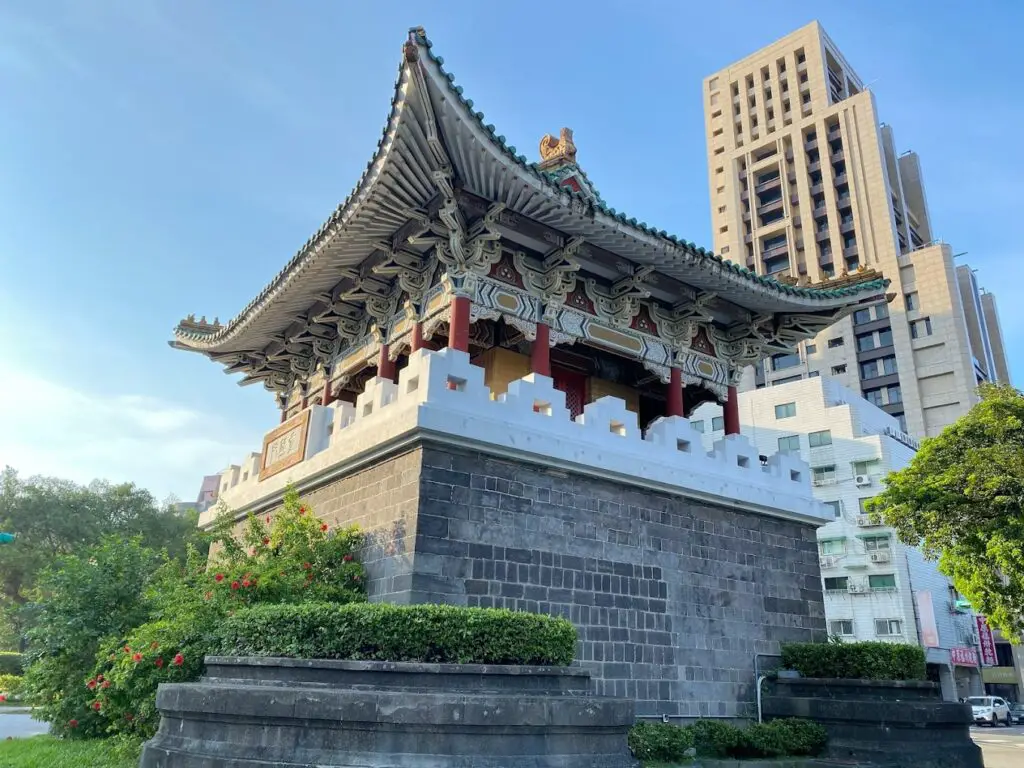
The Little South Gate, also known as Chongxi Gate, is a historical landmark in Taipei, Taiwan, and a remnant of the city’s original fortifications. Constructed during the Qing Dynasty in 1884, this gate served as a southern entrance to the walled city of Taipei. The gate’s strategic location was part of a defensive system designed to protect the settlement from potential external threats.
Over the years, Taipei has undergone significant urban development, and much of its original city wall has disappeared, making the Little South Gate a precious reminder of the city’s past. Situated in the bustling Ximending district, the Little South Gate is a small but distinctive structure with a traditional Chinese architectural design. It features a tiled roof, decorative eaves, and arched entryways.
While the gate itself is relatively modest in size, its historical significance and cultural value make it a notable attraction for both locals and tourists interested in Taipei’s heritage. The surrounding area has been revitalized, and the gate now stands as a charming juxtaposition against the modern urban landscape, offering a glimpse into Taipei’s rich history and evolution over time.
Location Map: https://maps.app.goo.gl/d6jDsbfx4HwK2fHk8
11. Taipei Tianhou Temple
The Taipei Tianhou Temple, also known as the Taipei Mazu Temple, is a venerable religious site dedicated to Mazu, the Chinese sea goddess. Located in the historic Wanhua District, the temple has a rich history dating back to its establishment in 1746 during the Qing Dynasty. This cultural and spiritual landmark is a significant center for the worship of Mazu, the guardian of fishermen and sailors.
The temple’s architecture is a fine example of traditional Chinese temple design, featuring intricate carvings, vibrant colors, and ornate decorations. Pilgrims and visitors are greeted by a majestic entrance adorned with guardian lion statues, leading to a courtyard with various halls dedicated to different deities.
The Taipei Tianhou Temple is not only a place of worship but also a hub for cultural events and celebrations, especially during important festivals dedicated to Mazu. The temple’s annual religious processions attract large crowds, featuring elaborately adorned palanquins carrying the goddess’s statue through the streets.
The vibrant atmosphere, traditional rituals, and historical significance make the Taipei Tianhou Temple a captivating destination for those interested in experiencing the intersection of spirituality and cultural heritage in Taiwan’s capital.
Location Map: https://maps.app.goo.gl/AMGqEVMbX94BfxtY9
12. Huashan 1914 Creative Park
Huashan 1914 Creative Park, located in Taipei, Taiwan, is a vibrant cultural and artistic hub situated in a former wine and sake brewery dating back to the Japanese colonial period. Established in 2005, the creative park has been transformed into a dynamic space that promotes and showcases Taiwan’s contemporary arts and creative industries.
The sprawling complex consists of preserved historic buildings and modern spaces, creating a unique blend of the old and the new. The park serves as a platform for exhibitions, performances, and cultural events, attracting artists, designers, and visitors from around the world.
Huashan 1914 Creative Park hosts a diverse range of activities, including art exhibitions, design markets, live performances, and workshops. The park’s commitment to fostering creativity and innovation is evident in its support for emerging artists and its role as a venue for cultural exchange.
Visitors can explore the various galleries, outdoor installations, and themed spaces that make up the park, offering a glimpse into Taiwan’s contemporary art scene. The adaptive reuse of the historical site and the infusion of modern artistic expressions make Huashan 1914 Creative Park a dynamic and evolving cultural destination, contributing significantly to Taipei’s status as a vibrant hub for the arts and creativity.
Location Map: https://maps.app.goo.gl/qDxHhafNkPC3a6pW8
13. Beitou Hotspring Museum
The Beitou Hot Spring Museum, located in the Beitou District of Taipei, Taiwan, is a charming cultural institution housed in a historic building that was originally the Beitou Public Bathhouse, built during the Japanese occupation in 1913. The museum’s architecture reflects a combination of Japanese and Western influences, creating a unique and visually appealing structure.
Since its conversion into a museum in 1998, it has become a popular destination for those interested in the history and cultural significance of hot springs in Taiwan. The museum provides insights into the development of Beitou as a hot spring destination, displaying artifacts, photographs, and interactive exhibits that highlight the historical and architectural aspects of the region.
Visitors to the Beitou Hot Spring Museum can explore the well-preserved facilities, including the elegant bathhouse interiors and outdoor hot spring pools. The museum’s exhibits detail the evolution of hot spring bathing rituals, the geothermal features of the area, and the cultural significance of hot springs in Taiwanese society.
Additionally, the museum is surrounded by the lush greenery of Beitou Park, creating a tranquil atmosphere for visitors to relax and enjoy the natural beauty of the surroundings. Whether for its historical charm or educational value, the Beitou Hot Spring Museum offers a unique and enriching experience, making it a notable attraction in Taipei.
Location Map: https://maps.app.goo.gl/GCLgjmeRTMMj7X2QA
14. Xiangshan
Xiangshan, also known as Elephant Mountain, is a popular natural landmark and hiking destination in Taipei, Taiwan, offering breathtaking panoramic views of the city skyline. Located near the Xinyi District, the trailhead is easily accessible from the Taipei 101 area.
The hiking trail is well-maintained, consisting of a series of stairs and pathways that wind through lush forested areas, providing a refreshing escape from the urban hustle. The main highlight of the hike is reaching the summit, where visitors are rewarded with stunning vistas of Taipei, including the iconic Taipei 101 skyscraper, against the backdrop of the surrounding mountains and cityscape.
Xiangshan is especially popular during the evening, as hikers can witness the city lights coming to life as the sun sets. The trail is equipped with strategically placed viewing platforms, allowing visitors to capture memorable photographs and enjoy the serene beauty of Taipei from an elevated perspective.
The relatively short hike, coupled with the remarkable views, makes Xiangshan a favorite among locals and tourists alike, providing an accessible outdoor experience for those seeking a combination of nature, exercise, and breathtaking scenery in the heart of the Taiwanese capital.
Location Map: https://maps.app.goo.gl/buKcuwdmmRwH4fmf6
15. Zhongshan Park
Zhongshan Park, situated in the Zhongshan District of Taipei, Taiwan, is a serene and picturesque public park that offers a peaceful retreat from the bustling urban environment. Established in 1884 during the Qing Dynasty, the park has a rich history and has undergone various transformations over the years.
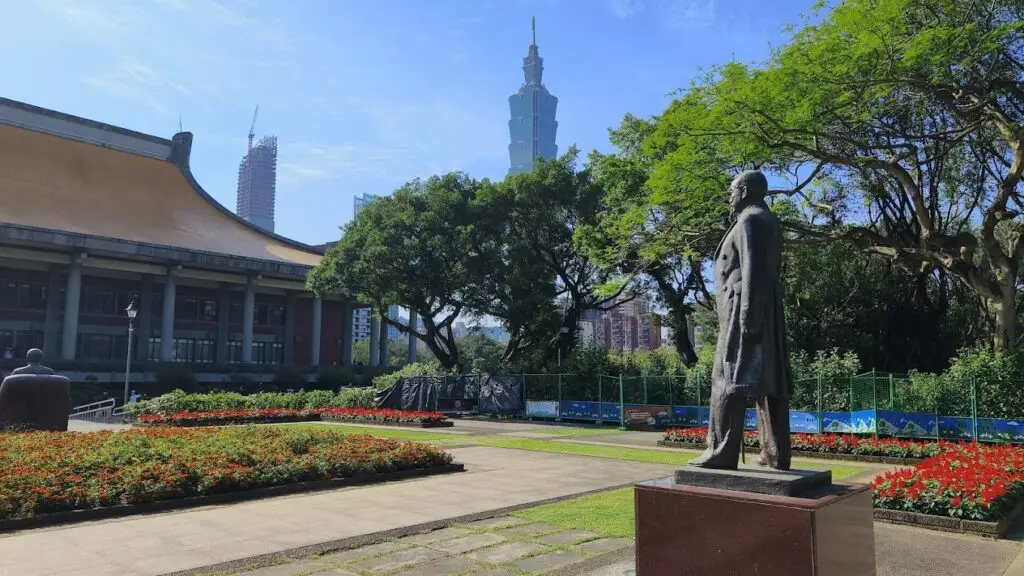
The expansive green space is adorned with well-maintained gardens, a large pond, and walking paths, creating a tranquil oasis in the heart of the city. The park is named after Sun Yat-sen, also known as Sun Zhongshan, the founding father of the Republic of China, and features a statue in his honor.
Zhongshan Park is not only a place for relaxation but also serves as a venue for cultural events and activities. The park hosts outdoor concerts, art exhibitions, and community gatherings, making it a vibrant hub for both locals and visitors. With its central location and diverse offerings, Zhongshan Park is a beloved destination for those seeking a balance between urban life and natural beauty, providing a welcome escape and recreational space in the midst of Taipei’s dynamic cityscape.
Location Map: https://maps.app.goo.gl/heX9W4Un4meCJRga9
16. Taipei Story House
Taipei Story House, situated in the historic Zhongshan District of Taipei, Taiwan, is a charming Western-style building that dates back to the early 20th century. Originally constructed in 1913 as the residence of a tea merchant, the building reflects a blend of Victorian and Baroque architectural styles, offering a unique contrast to the surrounding traditional Chinese architecture.
In 1993, the Taipei City Government designated the house as a historic site and transformed it into the Taipei Story House, a cultural and educational venue. The museum showcases the history of Taipei and Taiwan during the Japanese colonial period through a series of interactive exhibits, multimedia displays, and artifacts, providing visitors with insights into the cultural and social evolution of the region.
Within the Taipei Story House, visitors can explore various themed rooms that recreate the atmosphere of early 20th-century Taipei. The museum also hosts rotating exhibitions and cultural events, making it a dynamic space for learning and engagement. The beautifully preserved architecture, combined with its role as a cultural institution, makes Taipei Story House an intriguing destination for those interested in the historical narratives of Taipei and the cultural intersections that have shaped the city over the years.
Location Map: https://maps.app.goo.gl/YPZnbptGQXiTAqcr9
17. Raohe Street Night Market
Raohe Street Night Market, located in the Songshan District of Taipei, Taiwan, is one of the city’s oldest and most iconic night markets. Established in 1987, this bustling market stretches along Raohe Street, near the historic Ciyou Temple. The market is renowned for its vibrant atmosphere, diverse street food offerings, and a wide array of stalls selling clothing, accessories, and other goods.
As visitors enter the market through the ornate arch at the front gate, they are greeted by the enticing aroma of local delicacies and the lively sounds of vendors hawking their wares. One of the highlights of Raohe Street Night Market is its extensive selection of Taiwanese street food. From the famous pepper buns of Raohe Street to stinky tofu, oyster omelets, and various grilled skewers, the market provides a gastronomic adventure for food enthusiasts.
The lively ambiance, traditional architecture, and the mix of local flavors make Raohe Street Night Market a must-visit destination for those looking to experience the vibrant street culture and culinary delights that Taipei has to offer, especially after sunset when the market truly comes alive with colorful lights and enthusiastic crowds.
Location Map: https://maps.app.goo.gl/QeHJCxkCU93VFY6U7
18. Zhishan Garden
Zhishan Garden, located in the Shilin District of Taipei, Taiwan, is a peaceful and meticulously landscaped traditional Chinese garden situated near the National Palace Museum. Established in 1954, the garden is designed in the style of classical Chinese landscape architecture, featuring lush greenery, winding pathways, pavilions, and serene ponds. The garden provides a tranquil escape from the bustling city, allowing visitors to immerse themselves in the beauty of traditional Chinese horticulture.
Within Zhishan Garden, visitors can appreciate the harmonious integration of architectural elements and natural surroundings. The garden is home to various species of plants, including ornamental trees, flowering shrubs, and bamboo groves, creating a serene environment conducive to relaxation and contemplation.
The traditional structures within the garden, such as pavilions and bridges, offer picturesque spots for visitors to enjoy the scenery and engage in cultural appreciation. Zhishan Garden provides a delightful contrast to the modernity of Taipei, offering a space for reflection and appreciation of classical Chinese gardening techniques.
Location Map: https://maps.app.goo.gl/BoLS81Zq354FUvTu6
19. Ximending Walking District
Ximending, often referred to as the “Harajuku of Taipei,” is a vibrant and bustling pedestrian shopping district situated in the Wanhua District of Taipei, Taiwan. Established during the Japanese colonial era, Ximending has evolved into a trendy cultural and entertainment hub, drawing locals and tourists alike. The district is renowned for its eclectic mix of shops, boutiques, theaters, street food stalls, and entertainment options, creating a lively atmosphere that caters to a diverse range of interests.
Ximending Walking District is a melting pot of contemporary youth culture, fashion, and creativity. It features an array of international and local brand stores, as well as independent boutiques showcasing the latest trends. In addition to shopping, visitors can explore the district’s vibrant street art, indulge in a diverse range of local and international cuisine at the numerous eateries, and experience the lively street performances that often take place in the area.
As the sun sets, Ximending transforms into a colorful and illuminated entertainment district, with cinemas, arcades, and various entertainment venues ensuring that there is always something happening in this dynamic and culturally rich part of Taipei.
Location Map: https://maps.app.goo.gl/SYrbKubLzWa1JZ3U7
20. Taipei Grand Mosque
The Taipei Grand Mosque, situated in the Da’an District of Taipei, Taiwan, is a significant religious and cultural landmark for the city’s Muslim community. Established in 1960, the mosque serves as a place of worship for Taipei’s Muslim population and stands as a symbol of cultural diversity in the city.
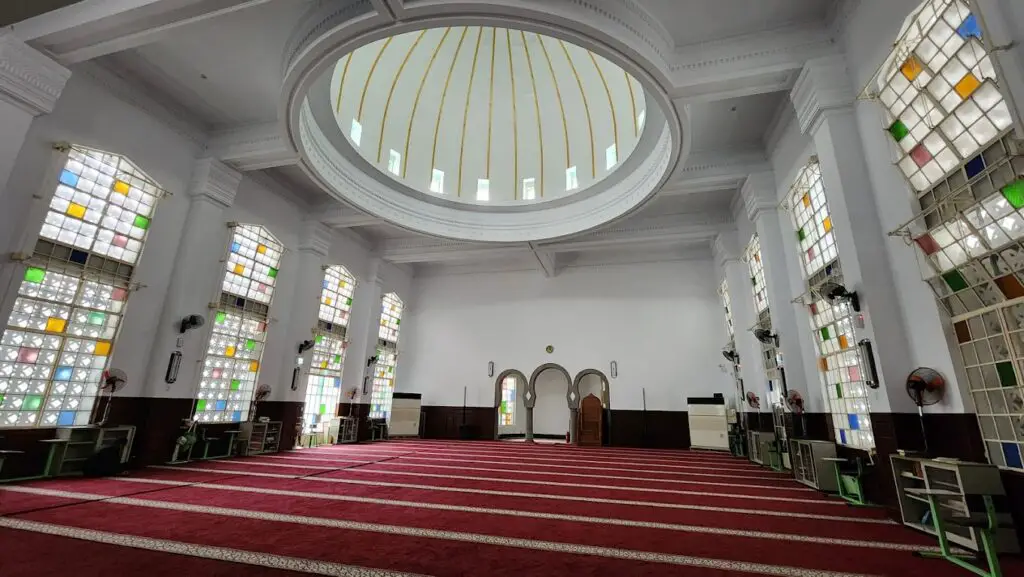
The mosque’s architecture combines traditional Islamic design elements with modern features, featuring a large dome, minarets, and intricate geometric patterns. The spacious prayer hall can accommodate a considerable number of worshippers, and the mosque is known for its welcoming atmosphere, welcoming both locals and visitors interested in learning about Islam.
In addition to its role as a religious institution, the Taipei Grand Mosque plays a crucial role in fostering cultural understanding and dialogue. It hosts educational programs, interfaith events, and community activities, promoting cross-cultural awareness and unity. The mosque’s location near the bustling Da’an District makes it easily accessible, and its serene ambiance provides a peaceful retreat for those seeking a moment of reflection or connection with the local Muslim community in Taipei.
Location Map: https://maps.app.goo.gl/mfuttUiaH26adm7L6
21. Xingtian Temple
Xingtian Temple, located in the Zhongshan District of Taipei, Taiwan, is one of the most prominent and historically significant temples in the city. Established in 1967, the temple is dedicated to Guan Gong, also known as Guangong or Guan Yu, a revered historical figure in Chinese culture and a symbol of loyalty and righteousness.
Xingtian Temple is distinctive for its architecture, featuring intricate carvings, colorful decorative elements, and a large statue of Guan Gong enshrined within the main hall. The temple’s cultural significance is evident in its role as a spiritual center and a venue for various religious and cultural events throughout the year.
Xingtian Temple is not only a place of worship but also a hub for cultural and community activities. The temple’s bustling atmosphere is characterized by worshippers burning incense, making offerings, and seeking divine guidance. Visitors to the temple can also participate in traditional rituals and witness lively religious ceremonies.
Xingtian Temple stands as a testament to the enduring importance of traditional Chinese religious practices in contemporary Taipei, providing a captivating glimpse into the intersection of spirituality, culture, and community in Taiwan’s capital.
Location Map: https://maps.app.goo.gl/dd8h3Nym3kT5tcrx8
22. Beitou Park
Beitou Park, nestled in the Beitou District of Taipei, Taiwan, is a serene and verdant oasis known for its natural hot springs and lush greenery. Established in 1913 during the Japanese colonial period, the park covers an expansive area and is surrounded by scenic mountains, creating a picturesque backdrop.
The centerpiece of Beitou Park is the Beitou Library, a beautiful wooden structure that blends traditional Japanese architecture with modern design. The park’s landscape features walking trails, ponds, and open spaces, offering visitors a tranquil environment to unwind and appreciate the beauty of nature.
One of the park’s notable attractions is the Thermal Valley, a geothermal hot spring area that emits sulfurous steam, creating an otherworldly atmosphere. Beitou Park is a popular destination for those seeking relaxation and rejuvenation, as it provides access to various public hot spring facilities.
The park also houses the Beitou Museum, which showcases the history and cultural significance of the Beitou area, including its role as a retreat for leisure and wellness. Whether enjoying a leisurely stroll, soaking in the hot springs, or exploring the cultural exhibits, Beitou Park stands as a multifaceted destination, blending natural beauty with cultural heritage in the northern part of Taipei.
Location Map: https://maps.app.goo.gl/kFzR9PiAMwhNvwwC8
23. Plum Garden
Plum Garden, located in the Shilin District of Taipei, Taiwan, is a historic residence turned cultural heritage site that offers a serene escape within the city. Originally built in the 1930s, the property served as the residence of Chinese calligraphy master Yu Youren.
The traditional Chinese architecture, lush gardens, and tranquil ambiance make Plum Garden a delightful retreat. The residence became a public park and cultural venue in 1996, allowing visitors to appreciate the unique blend of architectural beauty and natural surroundings.
The gardens surrounding Plum Garden are adorned with plum trees, adding to the scenic charm, especially when the plum blossoms bloom during the winter months. The property features classical Chinese buildings, including a traditional courtyard, pavilions, and the former residence of Yu Youren.
Today, Plum Garden hosts cultural events, art exhibitions, and calligraphy demonstrations, making it a cultural hub within Taipei. Its historical significance and artistic ambiance make Plum Garden a notable destination for those seeking a blend of traditional aesthetics and cultural enrichment in the heart of Taiwan’s capital city.
Location Map: https://maps.app.goo.gl/MB23g4NB8d7FB9Kf7
24. Suho Paper Memorial Museum
The Suho Paper Memorial Museum, located in Taipei, Taiwan, is a unique institution dedicated to preserving the history and art of traditional papermaking. The museum is situated in a historic building that once housed the Suho Paper Company, one of Taiwan’s leading paper manufacturers.
Established in 2001, the museum showcases the evolution of papermaking techniques and the cultural significance of paper in Taiwanese society. Visitors can explore the various exhibits, which include antique papermaking equipment, art installations, and hands-on workshops that provide insight into the intricate craft of traditional paper production.
The Suho Paper Memorial Museum aims to promote awareness and appreciation for the art of papermaking while preserving the rich heritage of this industry in Taiwan. The museum’s collection reflects the technological advancements and cultural developments in paper production, offering a comprehensive look at the role of paper in daily life and artistic expression.
The combination of educational exhibits and interactive experiences makes the Suho Paper Memorial Museum a fascinating destination for those interested in the history of craftsmanship and the cultural heritage of Taiwan.
Location Map: https://maps.app.goo.gl/Qv5q82ZmhDZX8PXHA
25. Taipei Confucius Temple
The Taipei Confucius Temple, situated in the Datong District of Taipei, Taiwan, is a significant cultural and religious landmark dedicated to Confucius, the revered Chinese philosopher and educator. Constructed in 1879, the temple adheres to traditional Chinese architectural styles, featuring intricate carvings, ornate roof decorations, and a serene courtyard.
The temple serves as a place of worship, education, and cultural preservation, reflecting Confucian values and principles. The main hall houses a statue of Confucius, and the surrounding halls are dedicated to his disciples and other notable figures in Confucianism.
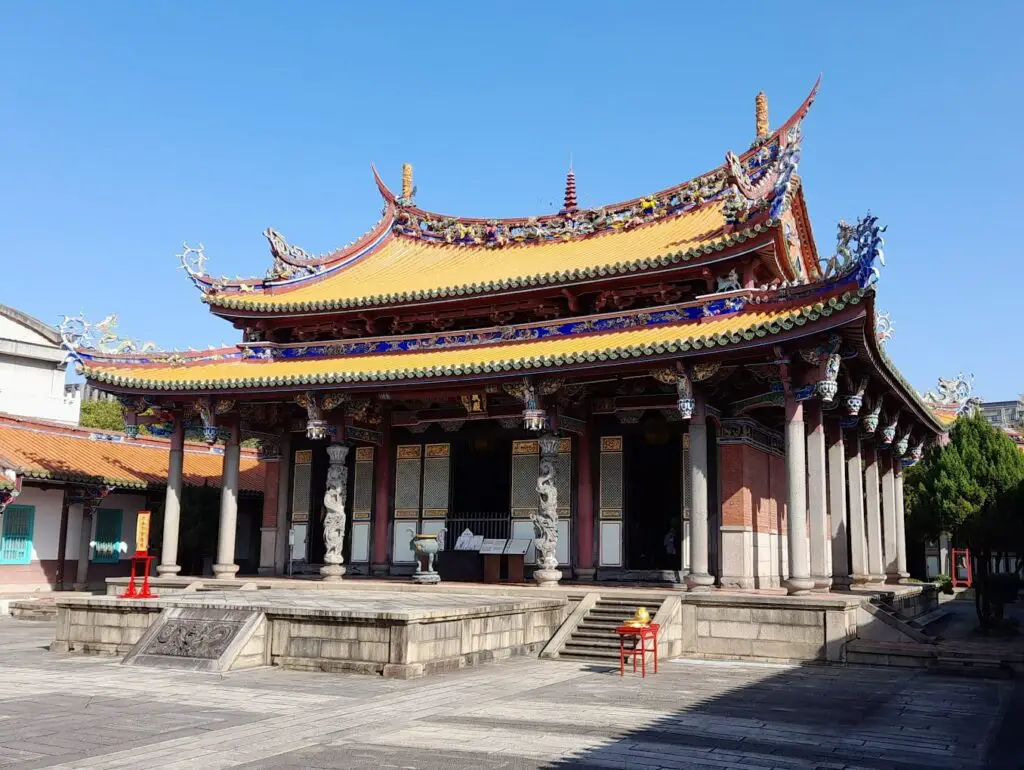
Beyond its religious functions, the Taipei Confucius Temple has also become a cultural center, hosting various events, ceremonies, and educational activities. Visitors to the temple can witness traditional Confucian rituals, explore the well-maintained grounds, and appreciate the historical artifacts and inscriptions on display.
The temple’s commitment to preserving Confucian traditions and teachings makes it a significant destination for those interested in Chinese philosophy, culture, and history in the heart of Taipei.
Location Map: https://maps.app.goo.gl/ip7dG5PCX2RkEYFS7
26. Qingtiangang Grassland
Qingtiangang, located within Yangmingshan National Park in Taipei, Taiwan, is a picturesque highland area renowned for its expansive grasslands and scenic beauty. The name “Qingtiangang” translates to “clear sky” in Chinese, reflecting the often clear and open skies that complement the rolling green hills. The grassland is situated in the volcanic terrain of Yangmingshan, surrounded by dormant volcanic cones, creating a unique landscape that blends nature and geology.
Visitors to Qingtiangang can enjoy panoramic views of the surrounding mountains, valleys, and Taipei City in the distance. The Qingtiangang Grassland offers a peaceful and serene escape from the urban hustle, providing a tranquil environment for hiking and relaxation. The well-maintained walking trails allow visitors to explore the grassy meadows while taking in the fresh mountain air.
The area is also known for its diverse flora, including seasonal wildflowers that add vibrant colors to the landscape. Qingtiangang is a popular spot for picnics and photography, providing a refreshing retreat for nature enthusiasts and those seeking a break from the city’s pace.
Location Map: https://maps.app.goo.gl/iNWpAFCNvR68Hboc7
27. National 228 Memorial Museum
The National 228 Memorial Museum in Taipei, Taiwan, is a poignant institution dedicated to preserving the memory of the 228 Incident, a tragic episode in Taiwan’s history that occurred in 1947. The museum was established in 1997 and is situated in the 228 Peace Memorial Park, which was named in remembrance of the incident.
The 228 Incident refers to the violent suppression of an anti-government uprising by the ruling Chinese Nationalist Party (Kuomintang) that resulted in widespread arrests, executions, and a period of martial law in Taiwan. The museum serves as a place of remembrance, education, and reflection, featuring exhibits that detail the historical context, events, and aftermath of the incident.
Visitors can explore artifacts, documents, and multimedia displays that provide insights into the social and political climate of the time, as well as the impact of the 228 Incident on Taiwan’s society. The National 228 Memorial Museum plays a crucial role in acknowledging and addressing Taiwan’s complex history, fostering a deeper understanding of the democratic journey the island has undertaken.
The museum not only serves as a memorial to the victims but also as a symbol of Taiwan’s commitment to democracy, human rights, and social justice. Its location within the 228 Peace Memorial Park adds to the significance of the site, offering visitors a peaceful and contemplative space to learn about a critical chapter in Taiwan’s history and its ongoing pursuit of justice and reconciliation.
Location Map: https://maps.app.goo.gl/ufbhRsuDp7Q6iHdf8
28. Zhishanyan Huiji Temple
Zhishanyan Huiji Temple, located in Taipei, Taiwan, is a venerable religious site dedicated to Guanyin, the Buddhist goddess of compassion. Originally established in the Qing Dynasty in 1767, the temple has undergone several renovations and expansions over the years. Situated in the Shilin District, Zhishanyan Huiji Temple is known for its traditional Chinese architectural style, featuring intricately carved stone facades, decorative elements, and ornate roof structures.
The temple’s historical significance and religious importance make it a cultural treasure in Taipei. The interior of Zhishanyan Huiji Temple houses a statue of Guanyin, attracting devout worshippers and visitors seeking spiritual solace. The temple is also renowned for its festive celebrations during important Buddhist and Taoist holidays, drawing crowds with colorful processions, traditional rituals, and cultural performances.
The serene atmosphere and cultural richness of Zhishanyan Huiji Temple contribute to its status as a sacred and cherished destination, providing both a place of worship and a testament to Taiwan’s diverse religious heritage.
Location Map: https://maps.app.goo.gl/RQMEVevjQJGDWBR49
29. Taiwan Provincial City God Temple
The Taiwan Provincial City God Temple, situated in Taipei, is a prominent religious site dedicated to Cheng Huang, the City God, who is believed to protect and govern the well-being of the local community. Originally established in 1856 during the Qing Dynasty, the temple has undergone renovations and expansions over the years.
It is located in the Wanhua District, an area with a rich historical and cultural heritage. The temple’s architecture is a splendid example of traditional Chinese temple design, adorned with intricate carvings, colorful decorations, and distinctive roof features.
Devotees and visitors to the Taiwan Provincial City God Temple come to seek blessings, offer prayers, and participate in various religious ceremonies. The temple plays a central role in local cultural events, particularly during festive occasions and traditional holidays.
The vibrant atmosphere, with the scent of incense wafting through the air, and the intricate details of the temple’s design contribute to its allure. The Taiwan Provincial City God Temple stands as a testament to the enduring importance of traditional religious practices and community spirituality in Taipei’s dynamic urban landscape.
Location Map: https://maps.app.goo.gl/bHvv87TDfeYuUE2m8
30. Linsen Park
Linsen Park, situated in the Zhongshan District of Taipei, Taiwan, is a picturesque urban oasis that provides a tranquil escape from the city’s hustle and bustle. Established in 1899, the park is one of the oldest public parks in Taipei and covers an area of approximately 4.7 hectares. Linsen Park is characterized by its lush greenery, walking paths, and serene pond, creating a peaceful environment for visitors to enjoy nature in the heart of the city.
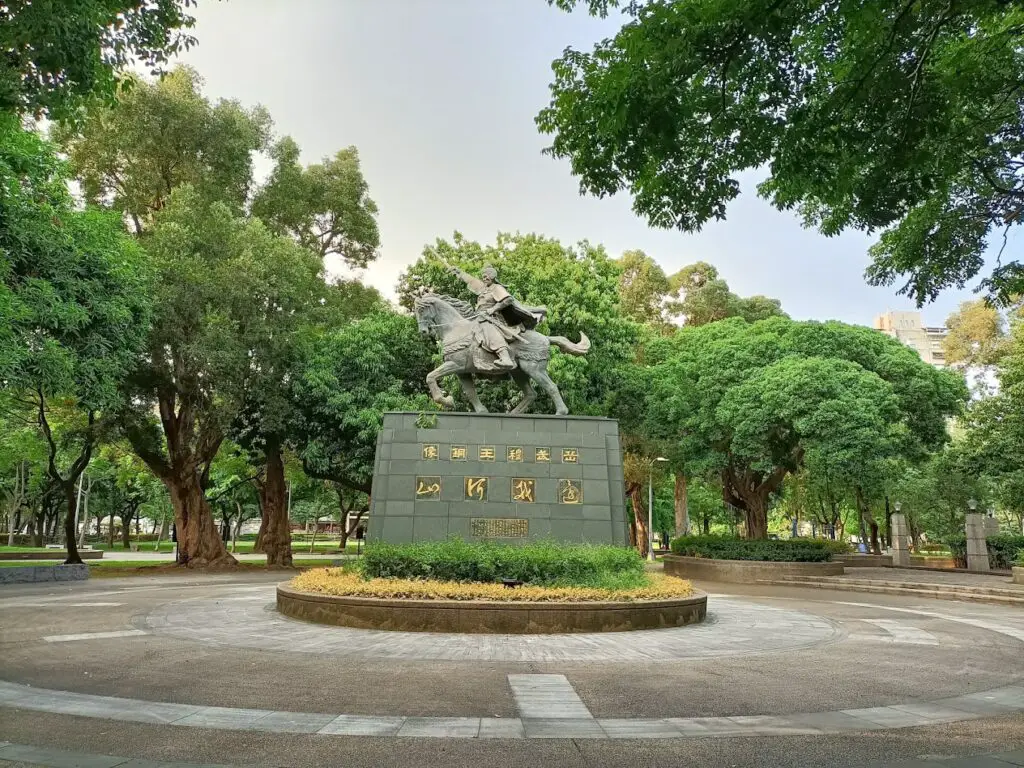
The park features a beautiful pavilion, bridges, and open spaces, making it a popular destination for locals and tourists alike. Linsen Park is a versatile space that caters to various interests, offering areas for relaxation, leisurely strolls, and recreational activities. The park’s historical significance, coupled with its well-maintained landscape and amenities, makes it a cherished urban retreat, providing respite and greenery for those seeking a moment of serenity in Taipei.
Location Map: https://maps.app.goo.gl/q9JDSC73QtscuBAA8
31. Xinbeitou Historic Station
Xinbeitou Historic Station, located in the Beitou District of Taipei, Taiwan, is a charming and historic railway station that reflects the region’s rich cultural and architectural heritage. Originally constructed in 1916 during the Japanese colonial era, the station served as a vital transportation hub for visitors traveling to the Beitou hot springs.
The station’s architectural style is a fusion of Japanese and Western influences, with wooden construction, a distinctive red-brick exterior, and elegant roof details. The station building underwent renovations and preservation efforts, maintaining its original charm while incorporating modern amenities.
In addition to its historical significance, Xinbeitou Historic Station now serves as a cultural and visitor center, providing information about the area’s history and attractions. The station is a gateway to the Beitou Hot Springs area and its surrounding attractions, including parks, museums, and hiking trails.
The quaint atmosphere and well-preserved architecture of Xinbeitou Historic Station make it not only a practical transportation point but also a delightful starting point for exploring the Beitou District and immersing oneself in the unique cultural and natural offerings of the region.
Location Map: https://maps.app.goo.gl/tzM2kHxsDpHF4cLd7
32. Thermal Valley
Thermal Valley, or Beitou Thermal Valley, is a geothermal hot spring area located in the Beitou District of Taipei, Taiwan. Renowned for its high temperatures and sulfurous steam emissions, Thermal Valley is often referred to as “Hell Valley” due to the otherworldly atmosphere created by the rising vapors.
The valley is a result of the region’s geothermal activity, with hot spring waters reaching temperatures of around 90 degrees Celsius (194 degrees Fahrenheit). This natural phenomenon has made Thermal Valley a significant attraction, drawing locals and tourists seeking to experience the therapeutic qualities of the hot springs.
Visitors to Thermal Valley can witness the powerful release of steam from the hot spring, creating an impressive spectacle. While direct bathing in the Thermal Valley is not permitted due to the extreme temperatures, the area is surrounded by public hot spring baths and resorts that utilize the geothermally heated water.
The valley is also part of the larger Beitou Hot Springs area, known for its numerous hot spring facilities, historic bathhouses, and scenic landscapes. Thermal Valley stands as a testament to the geological forces at work in the region and offers a unique opportunity for visitors to immerse themselves in Taiwan’s natural hot spring culture.
Location Map: https://maps.app.goo.gl/C6Fu73QCdbi1HS5r5
33. Yangmingshan Zhongshan Hall
Yangmingshan Zhongshan Hall, situated in the Yangmingshan National Park of Taipei, Taiwan, is a cultural and historical landmark with a rich legacy. Originally built in 1950 as a guesthouse for visiting dignitaries, the hall was later repurposed as a cultural center and venue for various events.
Its architectural style is a blend of Chinese and Western influences, featuring a distinctive red-brick exterior, white columns, and classical detailing. The hall is named after Sun Yat-sen, also known as Sun Zhongshan, the founding father of the Republic of China, and it serves as a tribute to his contributions to the nation.
Yangmingshan Zhongshan Hall is not only admired for its architectural elegance but also for its cultural significance. The hall hosts a range of performances, including traditional Chinese opera, music concerts, and art exhibitions, contributing to the city’s vibrant cultural scene.
Surrounded by lush greenery and located within the picturesque Yangmingshan National Park, the hall offers a tranquil setting for cultural appreciation and reflection. Its role as a cultural hub and its historical resonance make Yangmingshan Zhongshan Hall a captivating destination for both locals and visitors seeking a blend of natural beauty and artistic enrichment.
Location Map: https://maps.app.goo.gl/kh4b5uZEnMQAuJE7A
34. Shilin Night Market
Shilin Night Market, located in the Shilin District of Taipei, Taiwan, is one of the largest and most iconic night markets in the country. Established in the 19th century, the market has evolved into a bustling hub of street food, shopping, and entertainment, drawing locals and tourists alike.
Shilin Night Market is renowned for its vibrant atmosphere, with a labyrinthine network of alleys and stalls offering an extensive array of Taiwanese street food delicacies. From the famous “Shilin Fried Chicken” and oyster omelets to stinky tofu and bubble tea, the market provides a sensory feast for food enthusiasts eager to explore the diverse and delectable offerings of Taiwanese cuisine.
Beyond its culinary delights, Shilin Night Market offers a wide range of shopping opportunities, featuring stalls selling clothing, accessories, electronics, and more. The market also provides a glimpse into Taiwanese culture with its lively ambiance, traditional games, and street performances.
Open in the evening and stretching into the late hours, Shilin Night Market is a dynamic and energetic space that captures the essence of Taipei’s vibrant street culture, making it a must-visit destination for those looking to experience the lively spirit of Taiwan’s night markets.
Location Map: https://maps.app.goo.gl/hGN84aZ6niRvARWK9
35. Ketagalan Culture Centre
The Ketagalan Culture Centre, situated in Taipei, Taiwan, is a cultural institution dedicated to promoting and preserving the heritage of the Ketagalan indigenous people, one of Taiwan’s aboriginal communities. Opened in 2020, the center is located in the bustling Xinyi District, offering a space for education, cultural exchange, and the celebration of indigenous traditions.
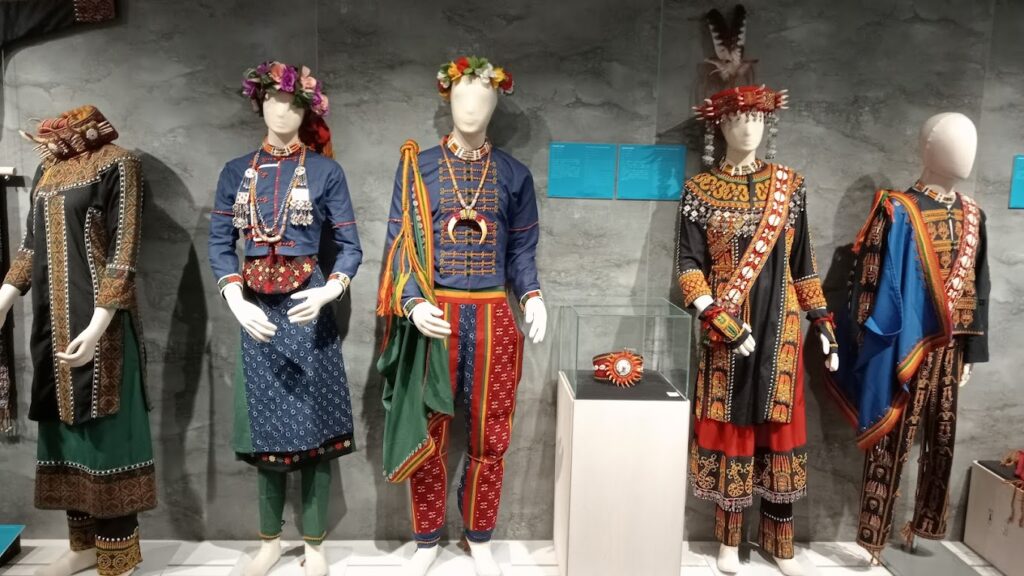
Named after the Ketagalan Plains, the ancestral homeland of the Ketagalan people, the culture center aims to raise awareness about the rich cultural diversity of Taiwan’s indigenous communities. The Ketagalan Culture Centre features exhibitions, workshops, and interactive displays that provide insights into the history, art, and customs of the Ketagalan people.
The center serves as a platform for fostering understanding and appreciation of indigenous cultures in Taiwan, highlighting the unique identity and contributions of the Ketagalan community. Visitors to the center can explore traditional artifacts, artworks, and multimedia presentations that showcase the resilience and vitality of the Ketagalan culture.
The establishment of the Ketagalan Culture Centre reflects Taiwan’s commitment to cultural diversity and the acknowledgment of the indigenous roots that enrich the nation’s history and contemporary identity.
Location Map: https://maps.app.goo.gl/BQn499acsnJn5ika6
36. Beitou Museum
The Beitou Museum, located in the Beitou District of Taipei, Taiwan, is a cultural institution housed in a historic building that was once the residence of Yu Youren, a renowned Chinese calligrapher and poet. Originally constructed in the early 20th century, the museum showcases the fusion of traditional Chinese and Western architectural elements, with a distinctive blend of wooden structures and tile roofing.
Opened to the public in 1989, the museum is dedicated to preserving and promoting the cultural heritage of Beitou and its significance as a hot spring destination during the Japanese colonial period. Visitors to the Beitou Museum can explore the various rooms, each curated to represent a different aspect of life in early 20th-century Taiwan.
The museum displays artifacts, documents, and photographs that offer a glimpse into the lifestyle, fashion, and cultural practices of the time. The beautifully landscaped gardens surrounding the museum provide a tranquil setting, enhancing the overall experience for visitors interested in the historical and cultural dimensions of Beitou.
The Beitou Museum is not only a cultural treasure but also a reflection of the region’s evolution, making it a compelling destination for those seeking to connect with Taiwan’s rich cultural heritage.
Location Map: https://maps.app.goo.gl/ue7mAyruu8krsWX47
37. Shung Ye Museum of Formosan Aborigines
The Shung Ye Museum of Formosan Aborigines, located in Taipei, Taiwan, is a cultural institution dedicated to preserving and showcasing the rich heritage of the island’s indigenous peoples. Established in 1994, the museum is situated in a modern building adorned with indigenous-inspired architectural elements.
The museum’s mission is to promote awareness and appreciation for the diverse cultures, traditions, and histories of Taiwan’s aboriginal communities. With a comprehensive collection of artifacts, traditional clothing, tools, and multimedia presentations, the museum provides a comprehensive overview of the unique customs and ways of life of the indigenous peoples of Taiwan.
One of the distinctive features of the Shung Ye Museum is its commitment to interactive and educational experiences. Visitors can engage in hands-on activities, attend workshops, and participate in demonstrations that offer insights into the traditional crafts and skills of the indigenous groups.
The museum also hosts cultural events and performances, further enriching the understanding of Taiwan’s indigenous cultures. By serving as a bridge between the past and the present, the Shung Ye Museum plays a vital role in fostering cultural exchange and appreciation, contributing to the broader recognition of the island’s diverse ethnic heritage.
Location Map: https://maps.app.goo.gl/ybk91NXaUxTVhtRM9
38. Taipei Cinema Park
Taipei Cinema Park, located in the Ximending area of Taipei, Taiwan, is a unique cultural and recreational space that celebrates the city’s cinematic history. Formerly the site of the iconic Taipei New Theater, the park was redeveloped in 2010 to honor its cinematic legacy. The park preserves the historical facade of the old theater while transforming the space into an open-air venue with public seating, making it an inviting spot for locals and visitors to gather and enjoy film-related activities.
The park is adorned with sculptures, film-themed installations, and murals, creating a vibrant atmosphere that pays homage to Taiwan’s film industry. Taipei Cinema Park hosts various events, including outdoor film screenings, film festivals, and cultural performances, making it a dynamic hub for film enthusiasts and the local community.
With its central location in Ximending, a district known for its cultural vibrancy, Taipei Cinema Park serves as a meeting point for film lovers, fostering a sense of community and appreciation for Taiwan’s cinematic heritage.
Location Map: https://maps.app.goo.gl/beH8BmuKgwsraz5Q8
39. Bangka Longshan Temple
Bangka Longshan Temple, located in the Wanhua District of Taipei, Taiwan, is one of the city’s oldest and most historically significant temples. Established in 1738, the temple has undergone several renovations and expansions, and it stands as a testament to the enduring cultural and religious heritage of the region. The temple is dedicated to Guanyin, the Buddhist goddess of mercy, along with other deities such as Mazu and Guan Gong, embodying a harmonious blend of Buddhist and Taoist influences in its worship practices.
Bangka Longshan Temple is renowned for its ornate architectural features, intricate carvings, and vibrant religious artwork. The temple’s design incorporates elements of Southern Chinese temple architecture, creating a visually striking and culturally rich environment. Devotees and visitors alike come to Bangka Longshan Temple to offer prayers, seek blessings, and witness traditional religious rituals. The temple’s central location and its role as a cultural and religious hub make it a revered destination for both spiritual practices and cultural exploration, reflecting the dynamic intersection of faith and history in Taipei.
Location Map: https://maps.app.goo.gl/D4hgZu4MjFTzKzUv9
40. Holy Family Catholic Church
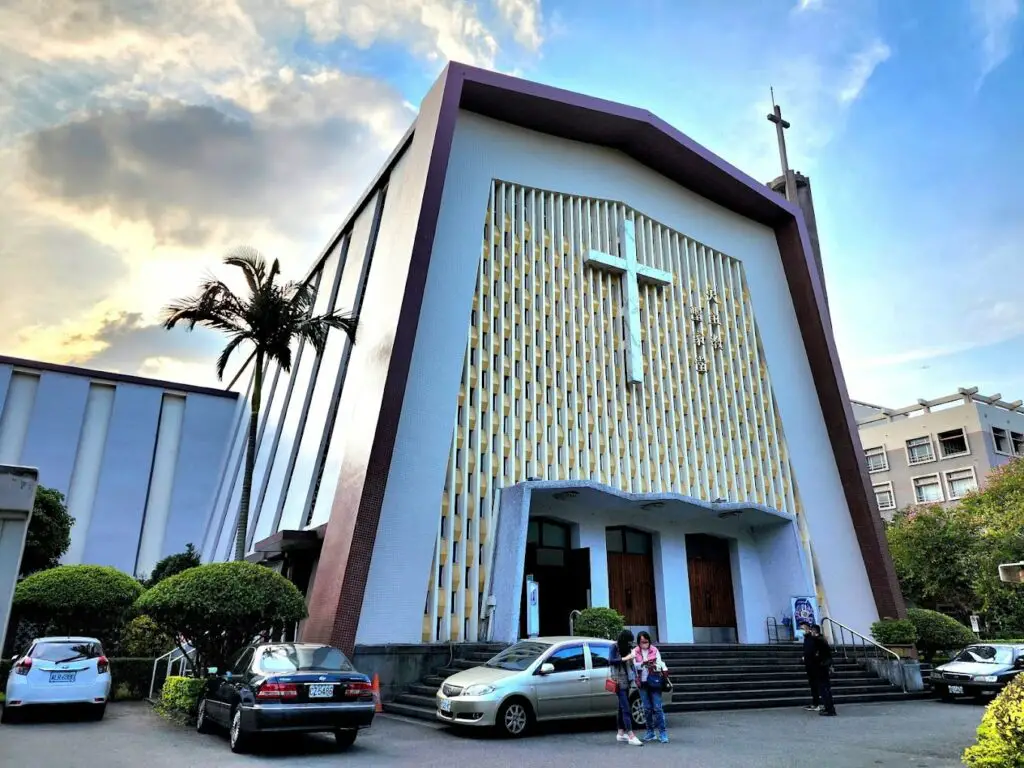
The Holy Family Catholic Church, located in Taipei, Taiwan, is a prominent religious institution that serves as the seat of the Archdiocese of Taipei. Established in 1963, the church stands as a significant symbol of Catholicism in Taiwan and is known for its distinctive modernist architecture. The design, featuring a circular main structure and a towering spire, was the work of Taiwanese architect Li Meishu. The church’s architectural uniqueness and cultural significance have made it a recognizable landmark in the city.
The Holy Family Catholic Church is not only a place of worship but also a center for community engagement and cultural activities. The church hosts religious ceremonies, events, and social programs, fostering a sense of community among its parishioners. The serene ambiance of the church, combined with its role as a spiritual and communal hub, makes the Holy Family Catholic Church a notable institution that contributes to the religious and cultural diversity of Taipei.
Location Map: https://maps.app.goo.gl/EMandmD9f9cJ3ZTM7
41. Xiaoyoukeng Recreational Area
Xiaoyoukeng, situated in Yangmingshan National Park near Taipei, Taiwan, is a unique recreational area known for its otherworldly landscape shaped by volcanic activity. The name “Xiaoyoukeng” translates to “Little Oil Pit,” reflecting the area’s characteristic sulfuric vents and fumaroles. Visitors to Xiaoyoukeng can witness the impressive steam vents and mud pots, which emit sulfurous gases, creating an otherworldly atmosphere.
The landscape is a result of the geothermal activity in the region, showcasing the raw power of the Earth’s forces. Apart from the geological marvels, Xiaoyoukeng offers hiking trails that allow visitors to explore the surrounding natural beauty. The trails provide panoramic views of the volcanic terrain, lush greenery, and even glimpses of Taipei City in the distance.
The recreational area is easily accessible and serves as a popular destination for those seeking both a geological spectacle and a refreshing outdoor experience. The dynamic combination of geological wonders and scenic hiking trails makes Xiaoyoukeng a captivating destination within Yangmingshan National Park.
Location Map: https://maps.app.goo.gl/gJKgdfow6W2SUoqx6
42. Qixing Park
Qixing Park, situated in the heart of Taipei, Taiwan, is a spacious and well-maintained urban park offering a peaceful retreat from the bustling city. Established in 1981, the park is named after Qixing Mountain, the highest peak in the Yangmingshan range. Its central location and expansive green spaces make Qixing Park a popular spot for locals and tourists alike.
The park’s design incorporates traditional Chinese garden elements, including pavilions, ponds, and walkways, creating a serene environment for relaxation and leisure. One of the key features of Qixing Park is its proximity to the iconic Taipei 101 skyscraper, providing a picturesque backdrop against the park’s lush scenery.
Visitors can enjoy leisurely strolls along the winding paths, engage in outdoor activities, or simply relax in the shade of the park’s trees. Qixing Park also hosts various events and cultural activities, contributing to its role as a dynamic public space within the city. Whether seeking a peaceful respite or a place for recreational pursuits, Qixing Park stands as a versatile and welcoming destination in Taipei.
Location Map: https://maps.app.goo.gl/5s5PLWMnmNJN1tXj6
43. Shifen Old Street
Shifen Old Street, located in the Pingxi District of New Taipei City, Taiwan, is a charming historic street known for its nostalgic atmosphere and traditional architecture. Originally established during the Japanese colonial era, the street has retained its historic charm, featuring well-preserved railway tracks, wooden storefronts, and red lanterns that add to its unique ambiance.
The area was once a bustling hub for coal mining activities, and today, Shifen Old Street is a popular destination for visitors seeking a glimpse into Taiwan’s past. One of the main attractions at Shifen Old Street is its iconic railway tracks, where visitors can participate in the tradition of releasing sky lanterns. Sky lanterns are colorful paper lanterns that carry written wishes and prayers into the sky when released.
This tradition has made Shifen Old Street a symbol of hope and celebration, attracting tourists who come to experience the magical moment of seeing numerous lanterns floating above the historic railway tracks. In addition to the lantern release, Shifen Old Street offers a variety of local snacks, souvenirs, and cultural experiences, making it a lively and nostalgic destination that captures the essence of Taiwan’s cultural heritage.
Location Map: https://maps.app.goo.gl/GpG5B8A3bEQ7stVf8
44. Jiufen Old Street
Jiufen Old Street, perched on the hillsides of New Taipei City, Taiwan, is a historic and atmospheric street renowned for its narrow alleys, traditional tea houses, and antique architecture. Originally developed during the Japanese colonial era, Jiufen gained prominence as a gold mining town, and its old street remains a captivating representation of Taiwan’s past. The narrow lanes are adorned with red lanterns, and the quaint teahouses and shops evoke a sense of nostalgia, transporting visitors back to a bygone era.
Jiufen Old Street is not only a visual delight but also a culinary haven, offering a diverse array of local Taiwanese snacks and delicacies. From the iconic taro balls and fishball soup to A-Mei Tea House, known for its panoramic views and cultural significance, the street is a food lover’s paradise. The bustling market atmosphere, combined with the scenic views of the mountains and sea, has made Jiufen Old Street a popular destination for both locals and tourists.
Its charm and cultural significance were further highlighted in the animated film “Spirited Away,” where Jiufen served as an inspiration for the enchanting setting. Today, the street remains a must-visit location for those seeking a unique blend of history, culture, and culinary delights in Taiwan.
Location Map: https://maps.app.goo.gl/W2HHr3pP55Y6yJS4A
45. Taipei Zoo
The Taipei Zoo, situated at the foothills of the Muzha District in Taipei, Taiwan, is one of the most extensive zoological gardens in Asia. Established in 1914, the zoo has continually expanded and evolved, showcasing a diverse collection of animals from around the world. The zoo is renowned for its commitment to conservation, education, and research, providing a space for both entertainment and learning.
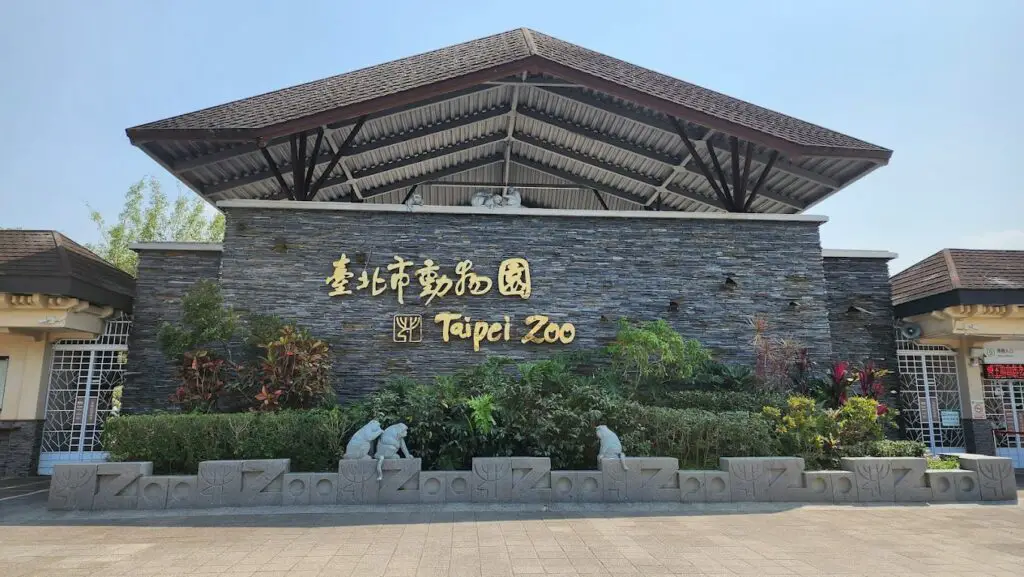
Divided into several themed areas, including the Asian Tropical Rainforest, Australian Animals, and the Formosan Animal Area, the Taipei Zoo houses over 400 species, totaling more than 4,000 animals. One of the zoo’s highlights is the Giant Panda House, where visitors can observe the beloved giant pandas, Tuan Tuan and Yuan Yuan, who were a gift from China in 2008.
The Taipei Zoo not only offers an opportunity for visitors to connect with wildlife but also emphasizes the importance of environmental conservation and animal welfare. With its educational programs, conservation initiatives, and spacious, well-designed exhibits, the Taipei Zoo stands as a family-friendly destination, promoting awareness and appreciation for the diverse fauna of our planet.
Location Map: https://maps.app.goo.gl/YxQm95PBmY33Pcrp9
46. Taipei 101 Observatory
The Taipei 101 Observatory, situated in the iconic Taipei 101 skyscraper, is a premier destination for breathtaking panoramic views of Taipei and its surroundings. Taipei 101 held the title of the world’s tallest building from 2004 until 2010 and remains an architectural marvel. The observatory, located on the 89th and 91st floors, provides visitors with a stunning 360-degree vista of the city, offering a unique perspective on Taiwan’s capital.
Apart from the awe-inspiring views, the Taipei 101 Observatory features interactive exhibits and displays that highlight the building’s engineering and architectural achievements. Visitors can learn about the skyscraper’s sustainable design, including its wind damper system, which enhances stability during typhoons and earthquakes.
The observatory experience also includes a high-speed elevator ride that whisks visitors to the top in a matter of seconds. Whether during the day or illuminated at night, the Taipei 101 Observatory stands as a symbol of Taipei’s modernity and technological prowess, providing an unforgettable experience for those seeking both architectural marvels and panoramic vistas.
Location Map: https://maps.app.goo.gl/xV5V6wtGohDNekeq6
47. The Red House
The Red House, located in Taipei’s Ximending district, is a historic and cultural landmark that stands as one of the city’s most recognizable structures. Built in 1908 during the Japanese colonial era, the Red House originally served as Taipei’s first public market. The building’s distinctive Western-style architecture, characterized by its red-brick façade and octagonal shape, adds to its unique charm.
Over the years, the Red House has undergone renovations and repurposing, evolving into a multi-functional space that combines historical significance with contemporary cultural activities. Today, the Red House is a cultural and creative center, hosting art exhibitions, performances, and cultural events.
The building’s interior features a marketplace where visitors can explore shops selling handmade crafts, artistic creations, and unique souvenirs. The surrounding area, known as the Ximending Red House Cultural and Creative Park, has become a vibrant hub for artistic expression, youth culture, and creative entrepreneurship.
The Red House’s role in fostering artistic endeavors and preserving historical heritage makes it a dynamic and beloved destination in Taipei, attracting both locals and tourists seeking a blend of cultural experiences and historical appreciation.
Location Map: https://maps.app.goo.gl/2NzJn9dRjvbaB2ARA
48. Taipei Botanical Garden
The Taipei Botanical Garden, established in 1921, is a lush and expansive green oasis nestled in the heart of Taipei, Taiwan. Covering an area of over 8 hectares, the garden serves as both a serene escape from the urban bustle and a center for botanical research and education. Situated near the Presidential Office Building, the garden is easily accessible and offers a diverse collection of plants, flowers, and trees.
Visitors to the Taipei Botanical Garden can explore themed areas such as the Orchid Pavilion, Palm Garden, and Economic Plants Area, each showcasing a variety of plant species. The garden is home to over 2,000 plant species, including rare and endangered ones, making it a valuable resource for conservation efforts.
The historic significance of the garden, combined with its educational programs and recreational spaces, makes it a popular destination for nature enthusiasts, families, and those seeking a tranquil retreat within the bustling city. Whether strolling along its meandering paths, participating in guided tours, or attending seasonal flower exhibitions, the Taipei Botanical Garden provides a harmonious blend of natural beauty and botanical knowledge for visitors of all ages.
Location Map: https://maps.app.goo.gl/yz3F2Y13p3UvAMGMA
What not to miss in Taipei?
In Taipei, several must-visit attractions include the iconic Taipei 101 Observatory for stunning city views, the historical and lively Shilin Night Market for local culinary delights, the culturally rich National Palace Museum housing invaluable Chinese artifacts, and the serene Yangmingshan National Park, known for its volcanic landscapes and hot springs. Additionally, exploring the vibrant Ximending district, visiting the Taipei Botanical Garden for a green escape, and experiencing the traditional atmosphere of Jiufen Old Street are all unmissable highlights that offer a diverse and enriching experience in Taiwan’s capital.
What is Taipei best known for?
Taipei is best known for its dynamic blend of modernity and tradition, with iconic landmarks like Taipei 101, once the world’s tallest building, dominating the skyline. Renowned for its vibrant night markets and other gastronomic adventures with diverse Taiwanese street food. Taipei is also famous for its cultural institutions, and home to an extensive collection of Chinese art and artifacts. The city’s lush green spaces, like Yangmingshan National Park and the Taipei Botanical Garden, provide a refreshing escape. Additionally, Taipei is celebrated for its friendly locals, efficient public transportation, and the lively atmosphere of districts like Ximending, making it a captivating destination with a unique fusion of tradition and modernity.
Is 3 days in Taipei worth it?
Absolutely, spending 3 days in Taipei is well worth it. The city offers a diverse range of attractions and experiences that can be comfortably explored within this timeframe. Visitors can marvel at the architecture and panoramic views from the Taipei 101 Observatory, immerse themselves in the cultural richness of places like the National Palace Museum and Jiufen Old Street, indulge in the culinary delights of night markets, and take in the natural beauty of Yangmingshan National Park. Taipei’s efficient public transportation makes it easy to navigate, and the city’s welcoming atmosphere and friendly locals enhance the overall experience. Whether you’re interested in history, culture, food, or nature, Taipei has something to offer for a memorable 3-day visit.
How many days in Taipei is enough?
Although Taipei offers ample opportunities for exploration, not everyone possesses the luxury of an extended stay in this bustling metropolis. A brief visit of 1 or 2 days allows for a glimpse of the city’s major attractions, but for a more comprehensive understanding of Taipei’s essence, we suggest a more extended stay of 3 to 5 days. This duration provides the chance to not only witness the prominent landmarks but also to delve deeper into the cultural fabric, discover hidden facets, and truly immerse oneself in the diverse and authentic experiences that Taipei has to offer.
Is it safe to walk in Taipei at night?
Taipei is widely recognized as a secure destination for women traveling alone, even during nighttime. The city boasts well-lit streets, and its efficient public transportation operates until midnight, ensuring convenient and safe travel. With a relatively low crime rate, Taipei is considered a secure environment, and residents are generally known for their respectful and courteous behavior.
Is Taipei a walkable city?
Yes, Taipei is known for being a walkable city, particularly in its central districts. Areas like Xinyi, Zhongzheng, and Da’an feature well-designed sidewalks, pedestrian-friendly streets, and numerous attractions within reasonable walking distance. The city’s efficient public transportation system, including the MRT (Mass Rapid Transit) system, also facilitates easy movement between different neighborhoods. While some parts of Taipei are more conducive to walking, others may require alternative modes of transportation, such as buses or the MRT, especially when exploring areas farther from the city center. Overall, Taipei provides a blend of walkability and efficient public transit options, allowing residents and visitors to navigate the city conveniently.
What is a good month to visit Taipei?
A good month to visit Taipei is during the fall season, which typically spans from September to November. During this period, the weather is relatively mild and comfortable, with temperatures ranging from 20 to 25 degrees Celsius (68 to 77 degrees Fahrenheit). Fall brings lower humidity, clearer skies, and a reduction in rainfall, providing favorable conditions for outdoor exploration and sightseeing. Additionally, this season showcases Taipei’s natural beauty, with the surrounding mountains, parks, and gardens displaying vibrant autumn foliage. Keep in mind that individual preferences may vary, and some travelers might also enjoy the spring season (March to May) when temperatures are mild, and cherry blossoms bloom, adding a touch of beauty to the city.
Is it safe to walk around Taipei?
Yes, Taipei is generally considered a safe city, and walking around is generally safe, even at night. The city has a reputation for being one of the safest in the world. Crime rates are relatively low, and violent crime is rare. The streets are well-lit, and there is a strong police presence throughout the city, contributing to a sense of security for residents and visitors alike. However, as with any large city, it’s always advisable to take standard precautions such as being aware of your surroundings, securing your belongings, and using well-traveled routes, especially during the nighttime. Overall, Taipei is known for its safety, making it a comfortable destination for walking and exploring.
Is Taipei cheap for tourist?
Taipei is generally considered an affordable destination for tourists, offering a range of options to suit various budgets. Accommodation, food, and transportation can be relatively inexpensive compared to many Western cities. Street food in Taipei’s night markets is not only delicious but also affordable, making it a popular choice for budget-conscious travelers. Public transportation, including the MRT (Mass Rapid Transit) system, is efficient and reasonably priced.
While Taipei provides opportunities for budget-friendly travel, the city also caters to those seeking luxury experiences with upscale hotels, dining, and entertainment options. It’s worth noting that individual spending preferences vary, and Taipei can accommodate both budget and luxury travelers. Overall, many visitors find Taipei to be a cost-effective destination with a good balance of affordability and quality experiences.
Is Taipei easy to get around?
Yes, Taipei is generally easy to get around. The city has a well-developed and efficient public transportation system, including the Mass Rapid Transit (MRT) system, buses, and a network of taxis. The MRT, in particular, is known for its reliability, cleanliness, and extensive coverage, making it a convenient option for navigating the city and reaching various attractions.
Additionally, Taipei is a pedestrian-friendly city, especially in central districts like Xinyi and Zhongzheng, where you’ll find well-maintained sidewalks and pedestrian crossings. Many of the city’s attractions, shops, and restaurants are within walking distance of MRT stations, allowing for easy exploration on foot.
For those who prefer cycling, Taipei also has a bike-sharing system called YouBike, providing another eco-friendly and convenient means of transportation. Overall, the combination of public transportation, walkability, and cycling options makes Taipei a city that is generally easy to navigate for both residents and visitors.
What should I wear in Taipei?
When visiting Taipei, it’s advisable to dress comfortably and in layers, as the city experiences a subtropical climate with distinct seasons. In the spring (March to May), lightweight clothing, such as T-shirts, shorts, and breathable fabrics, is suitable as temperatures are mild. Summers (June to August) can be hot and humid, so lightweight, loose-fitting clothing, shorts, and short-sleeved shirts are recommended. A light jacket or sweater may be useful for indoor spaces with air conditioning.
Fall (September to November) is a pleasant time, and you can opt for similar clothing to spring. Winter (December to February) can be cool, so bring a jacket or coat, especially in the evenings. It’s also a good idea to check the weather forecast before your trip to ensure you pack accordingly. Comfortable walking shoes are advisable, especially if you plan on exploring the city on foot. Additionally, if you plan to visit religious or cultural sites, it’s respectful to have more conservative clothing, covering shoulders and knees.
Is it safe to drink tap water in Taipei?
Yes, it is generally safe to drink tap water in Taipei. Taiwan has strict water quality standards, and the tap water undergoes rigorous testing to ensure its safety for consumption. The water treatment and supply infrastructure in Taipei is well-developed, providing clean and potable water to residents and visitors.
If you have any concerns or prefer, you can also find bottled water widely available in Taipei, and many locals and tourists choose to drink bottled water for convenience. Additionally, in restaurants and eateries, you’ll often be served complimentary boiled water or have the option to request it.
Is Taipei English friendly?
Yes, Taipei is generally English-friendly, especially in areas frequented by tourists, major attractions, and business districts. Many people in Taipei, especially those in the service industry, including hotels, restaurants, and transportation services, have a basic understanding of English. Signs and information in popular tourist areas are often available in English as well.
In recent years, there has been an effort to enhance English language proficiency, and you may find that younger generations and those working in the tourism sector are more proficient in English. While language barriers may exist in some local markets or less touristy areas, overall, Taipei is considered a destination where English-speaking travelers can navigate comfortably. Learning a few basic Mandarin phrases can still be helpful and appreciated, but English communication is generally sufficient for most visitors in Taipei.
What to buy back from Taipei?
Taipei offers a variety of unique and culturally significant items that make for great souvenirs. Here are some popular things to buy back from Taipei:
- Taiwanese Tea: Taiwan is renowned for its high-quality teas, including oolong, green, and black varieties. Consider purchasing locally produced tea leaves or beautifully packaged tea sets.
- Bubble Tea Products: Taipei is the birthplace of bubble tea, so why not bring home some bubble tea kits, tapioca pearls, or flavored syrups to recreate this popular drink.
- Traditional Chinese Ceramics: Taipei is known for its traditional ceramics. Look for intricately designed tea sets, bowls, and vases that showcase the city’s craftsmanship.
- Local Snacks: Bring back some of Taiwan’s delicious snacks, such as pineapple cakes, sun cakes, or various flavored mochi. These make for tasty gifts.
- Chinese Calligraphy and Artwork: Explore the local art scene and consider buying traditional Chinese calligraphy, paintings, or artworks from local artists.
- Taipei 101 Souvenirs: Items related to Taipei 101, like miniature replicas, keychains, or stationary with the iconic building’s design, can be great reminders of your trip.
- Local Handicrafts: Taipei has a thriving arts and crafts scene. Look for handmade items like traditional Taiwanese puppets, handwoven textiles, or intricate woodwork.
- Personalized Seal/Chop: Have a personalized seal or “chop” made with your name in traditional Chinese characters. These are often made of stone or wood and are a unique and meaningful souvenir.
Remember to explore local markets, specialty stores, and cultural districts for the best selection of authentic and distinctive Taipei souvenirs.
Is Taipei good for clothes shopping?
Yes, Taipei is a fantastic destination for clothes shopping, offering a diverse range of shopping experiences, from high-end boutiques to vibrant street markets. Here are some popular shopping areas in Taipei:
- Ximending: Known as the “Harajuku of Taipei,” Ximending is a trendy district with a plethora of shops, boutiques, and department stores. It caters to a youthful and fashion-forward crowd, offering the latest styles and streetwear.
- Zhongxiao East Road: This area is home to numerous department stores and international brand outlets. The malls along Zhongxiao East Road, such as Taipei 101 Mall and Bellavita, showcase a mix of luxury and high-street fashion.
- Shilin Night Market: While famous for its street food, Shilin Night Market also offers a variety of clothing stalls. You can find trendy and affordable fashion items, accessories, and unique pieces.
- Wufenpu: A wholesale garment district, Wufenpu is a bustling area with numerous small shops and stalls selling a wide variety of clothes at reasonable prices. It’s an excellent place to discover the latest fashion trends.
- Raohe Street Night Market: Similar to Shilin, Raohe Street Night Market also has a section dedicated to clothing and accessories. It’s a great spot for finding both traditional and trendy fashion items.
- Taipei Main Station Underground Mall: This extensive underground shopping area connected to Taipei Main Station features numerous shops selling clothing, accessories, and footwear.
Whether you’re looking for international brands, local designers, or budget-friendly fashion, Taipei offers a diverse and vibrant shopping scene that caters to a wide range of tastes and preferences.
What month do typhoons hit Taipei?
The typhoon season in Taipei and Taiwan typically occurs from June to October, with the peak of activity usually happening between July and September. During this period, the region may experience typhoons or tropical storms, bringing heavy rainfall, strong winds, and potential flooding.
It’s important to note that typhoons are unpredictable, and their paths can vary. While Taipei itself is not always directly hit by the eye of the typhoon, the city can still experience the effects, including heavy rain and strong winds.
If you plan to visit Taipei during the typhoon season, it’s advisable to stay informed about weather forecasts and be prepared for potential disruptions to travel plans. Some outdoor attractions and activities may be affected during typhoon warnings, so it’s essential to stay updated on local advisories during your stay.
Is it safe to eat street food in Taipei?
Eating street food in Taipei is generally considered safe and is, in fact, a quintessential part of the city’s culinary experience. Taipei is renowned for its vibrant street food culture, offering a diverse array of delicious snacks and local delicacies. Tourists and locals alike flock to the city’s numerous night markets and street corners to indulge in affordable and flavorful treats.
The city takes food safety seriously, and street vendors are subject to regular inspections to ensure compliance with hygiene standards. While exploring the bustling night markets like Shilin or Raohe Street, visitors can find an abundance of popular and reputable stalls. These busy vendors, often with a queue of locals, are a good indicator of both the quality and safety of the food being offered.
Is taxi cheap in Taipei?
Taxis in Taipei are generally considered affordable, especially when compared to taxi services in many Western countries. The initial fare is reasonable, and the metered rates increase gradually based on distance traveled and time spent in the taxi. Taxis are readily available throughout the city, and drivers are usually honest and use the meter without issue.
Although Taipei’s vibrant yellow taxis are the priciest among the public transportation choices, they remain quite inexpensive when measured against global standards. Typically, a ride spanning the entire city will cost less than NT$250.
It’s important to note that there may be additional charges for tolls or late-night travel, so it’s advisable to confirm the fare with the driver or check for any surcharges before starting your journey. Overall, while not the cheapest mode of transportation, taxis in Taipei provide a comfortable and efficient way to get around the city.
How do I pay for Taipei MRT?
Paying for the Taipei Metro (MRT) is a straightforward process. Upon entering the metro station, you can purchase a single-journey token from the ticket vending machines, choosing your destination and fare accordingly. The machines accept both cash and EasyCard, a rechargeable smart card widely used for public transportation and other services in Taipei. Alternatively, if you have an EasyCard or iPass, simply swipe your card at the entrance gates when entering and exiting the MRT system. EasyCards can be conveniently recharged at the machines or service counters within the stations. This contactless payment system makes using the Taipei MRT efficient and user-friendly for both locals and visitors alike.
How much is a taxi from Taipei airport to city?
The taxi fare from Taipei Taoyuan International Airport to the city center can vary depending on the exact destination within Taipei. The approximate cost is around NT$1,200 to NT$1,500. Keep in mind that this is an estimate, and actual fares may vary based on factors such as traffic conditions and the specific location within the city.
It’s worth noting that there are other transportation options from the airport to the city, such as the Airport MRT (Mass Rapid Transit) and airport buses, which may offer more budget-friendly alternatives. The MRT, in particular, is a convenient and cost-effective way to reach various parts of Taipei from the airport.
Conclusion
As we draw the curtain on our exploration of Taipei’s treasures, it’s evident that this city has woven a tapestry of experiences that leave an indelible mark on every traveler. From the panoramic views of Taipei 101 to the sensory extravaganza of its night markets, Taipei is a destination that invites you to delve into its rich cultural heritage and dynamic urban energy. Whether you’re savoring local delicacies at Raohe Street Night Market, finding tranquility in the city’s temples, or navigating the bustling streets of Ximending, Taipei unfolds as a city of endless discovery. The best things to do in Taipei are not just a checklist but a journey, an immersion into a city that effortlessly harmonizes tradition and innovation, making every moment a vibrant chapter in the tale of this remarkable Taiwanese metropolis.



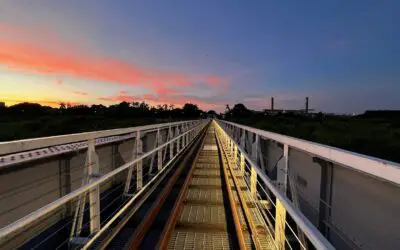
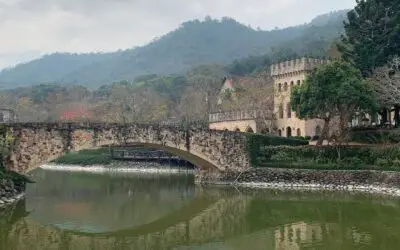
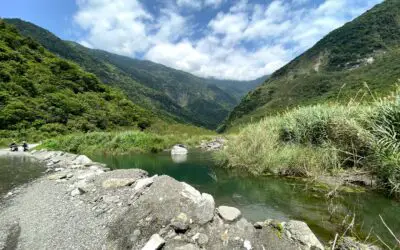
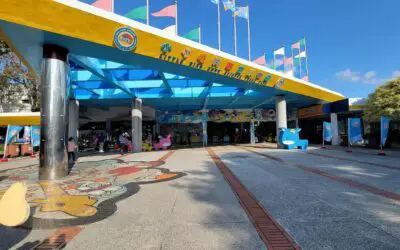
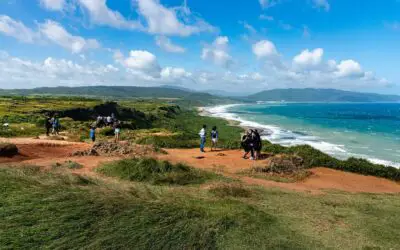
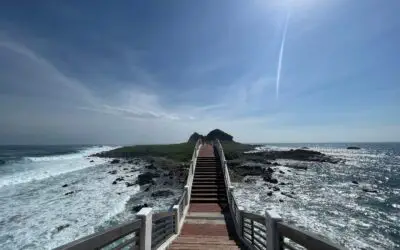
0 Comments